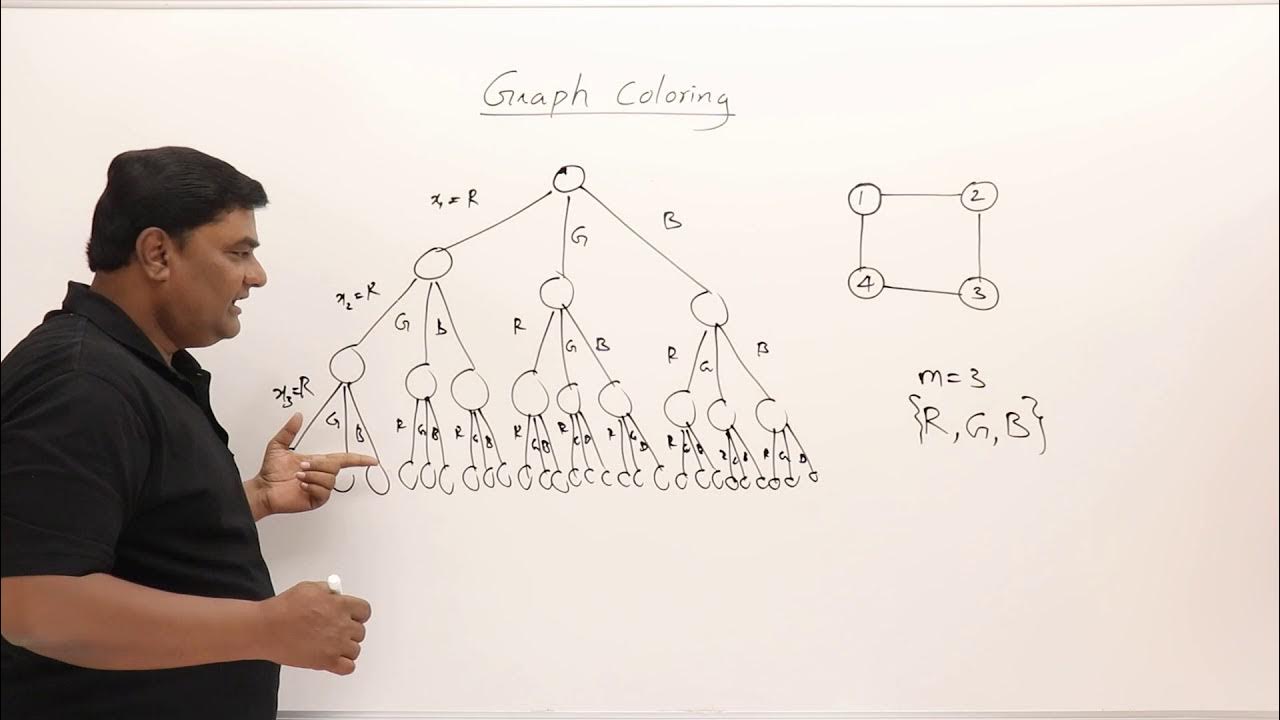Pewarnaan Graf (Graph Coloring) PART 1 | Algoritma Welch Powell & Contoh kasus penjadwalan kuliah
Summary
TLDRThis video explains the concept of graph coloring in graph theory, focusing on vertex coloring to solve scheduling problems. Using the Welch-Powell algorithm, it demonstrates how to assign colors to the vertices of a graph (representing courses) such that no two adjacent vertices share the same color. The example involves 10 students and 6 courses, showing how to schedule exams or classes efficiently with minimal conflicts. The solution results in three distinct scheduling sessions, optimizing time and resource usage while ensuring no course overlaps for students.
Takeaways
- 😀 The topic of the video is graph coloring in graph theory, specifically focusing on vertex coloring.
- 😀 Graph coloring involves labeling the elements of a graph, such as vertices or edges, with colors to avoid conflicts between adjacent elements.
- 😀 There are three types of graph coloring problems: vertex coloring, edge coloring, and region coloring. This video focuses on vertex coloring.
- 😀 Vertex coloring assigns colors to vertices in a graph such that no two adjacent vertices share the same color.
- 😀 A typical application of vertex coloring is scheduling, such as scheduling university exams or classes to avoid conflicts between students.
- 😀 The algorithm commonly used for vertex coloring is the Welch-Powell algorithm, which begins by selecting a vertex with the highest degree as the starting vertex.
- 😀 The Welch-Powell algorithm assigns colors to vertices by choosing non-adjacent vertices and coloring them with the same color until no more can be assigned.
- 😀 Once all vertices are colored, a final scheduling solution is derived from the graph coloring, ensuring that no students have scheduling conflicts.
- 😀 In the example given, 10 students are taking 6 different courses, and the problem is to create a schedule without conflicts, which is represented as a graph.
- 😀 The solution to the scheduling problem involves finding the minimum number of exam sessions or class slots, which can be achieved with three sessions based on the graph coloring result.
Q & A
What is graph coloring in the context of graph theory?
-Graph coloring refers to assigning labels (or colors) to the elements of a graph, typically vertices, such that adjacent vertices have different colors. This technique is often used to solve problems like scheduling or assigning resources without conflicts.
What is the practical application of graph coloring mentioned in the script?
-The practical application mentioned is in scheduling exams or courses, where the goal is to ensure that students who share courses do not have overlapping exam times or class schedules.
What are the three types of graph coloring problems?
-The three types of graph coloring problems are: vertex coloring (assigning colors to vertices), edge coloring (assigning colors to edges), and region coloring (assigning colors to regions or areas).
What is the focus of this script regarding graph coloring?
-This script focuses on vertex coloring, which involves assigning colors to vertices such that no two adjacent vertices share the same color.
What is the Welch-Powell algorithm, and how is it used in this context?
-The Welch-Powell algorithm is a heuristic algorithm used for graph coloring. In this context, it is used to assign colors to the vertices of a graph (representing courses or exams) while ensuring that no adjacent vertices share the same color, thus avoiding scheduling conflicts.
What is the first step of the Welch-Powell algorithm?
-The first step is to choose the vertex with the highest degree, meaning the vertex with the most adjacent edges. This vertex is then assigned the first color.
How does the Welch-Powell algorithm proceed after the first vertex is colored?
-After coloring the first vertex, the algorithm proceeds by selecting other vertices that are not adjacent to the already colored vertex and assigns them the same color. The process continues until all vertices are colored.
How are conflicts represented in the scheduling problem discussed in the script?
-Conflicts are represented by edges between vertices. If two students are enrolled in the same course, an edge is drawn between the corresponding course vertices to indicate a conflict, meaning they should not be scheduled at the same time.
What is the goal of the vertex coloring in the scheduling context?
-The goal is to assign timeslots (colors) to courses (vertices) such that no two courses that share a student (adjacent vertices) are scheduled at the same time.
How many timeslots (or colors) were found to be necessary for the scheduling problem?
-The algorithm determined that only three timeslots (or colors) were necessary to avoid conflicts and successfully schedule all courses without overlaps.
Outlines

このセクションは有料ユーザー限定です。 アクセスするには、アップグレードをお願いします。
今すぐアップグレードMindmap

このセクションは有料ユーザー限定です。 アクセスするには、アップグレードをお願いします。
今すぐアップグレードKeywords

このセクションは有料ユーザー限定です。 アクセスするには、アップグレードをお願いします。
今すぐアップグレードHighlights

このセクションは有料ユーザー限定です。 アクセスするには、アップグレードをお願いします。
今すぐアップグレードTranscripts

このセクションは有料ユーザー限定です。 アクセスするには、アップグレードをお願いします。
今すぐアップグレード関連動画をさらに表示

Abordagem da Coloração em Grafos | Teoria dos Grafos | 2025.1

Introduction to Graph Theory: A Computer Science Perspective

6.3 Graph Coloring Problem - Backtracking

Teori Graf dan Pemanfaatannya

Graph Terminology || Types of Graphs || Graph Theory || Complete Graph || Regular Graph || DMS || DS

Pewarnaan Graf (Graph Coloring) PART 2 | Algoritma Welch Powell & Contoh kasus penyimpanan zat kimia
5.0 / 5 (0 votes)
